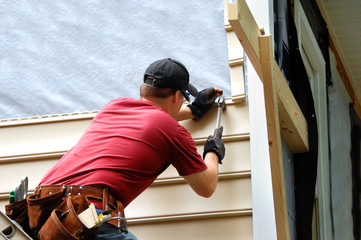Siding is a crucial part of a home’s exterior. It protects the walls from wind, rain, and snow and adds a sense of beauty. Damaged siding not only looks bad, but it can also lead to water intrusion and increase heating and cooling costs. That’s why the timely repair is important.

Choosing a durable product is the best way to protect your siding from this problem. The right siding will not only keep moisture out but will also help prevent mold and mildew buildup. It’s also a good idea to caulk all your siding seams, especially those near windows, and doors. You can also use a caulking gun to fill in cracks and sunken nail holes that might be causing water infiltration. This is a great way to avoid costly repairs in the future! Also, hiring an experienced Siding Repair can ensure your house is properly sealed.
Siding can change and deform due to a variety of causes. It could result from incorrect installation, weather damage, or general wear and tear over time. Warped or bulging boards are often just the tip of the iceberg and can be difficult to fix, so it’s important to have them looked at by a professional. These boards are often the first sign of a larger problem that may require full siding replacement.
Aside from the normal aging process, it’s also possible for wood to warp or bulge because of moisture and poor material quality. This is especially true of cedar siding and other types of wood that are more susceptible to warping than vinyl or aluminum. Warped and bulging boards can be fixed by tightening, shortening, or repairing the boards. Additionally, it’s important to keep heat sources such as grills, stoves, and fire pits away from the siding. This will prevent them from melting the siding.
A good roof is vital to your home’s defense against the elements. It protects you and your property from rain, snow, wind, and even hail. If shingles are missing or loose, it’s time for a roofing repair job. Leaving these issues unattended can lead to many problems, including leaks and water damage. Shingles are usually installed in a multilayered design to minimize the risk of leaks and other issues. If the shingles are properly attached or installed by an inexperienced contractor, they can stay on your roof.
Loose or missing shingles can increase your risk of leaks, which can cause extensive damage to the interior and exterior of your home. This can be very expensive to fix. Other signs that you may need to replace your shingles include small cracks or holes in the asphalt, curling of the shingle surface when dry, and nails that are partially pulled out of the asphalt. These signs indicate that your shingles are nearing the end of their lives and won’t keep water out of your home for much longer.
If you have siding that has cracks or pits, it’s best to fix them as soon as possible. Not only does this prevent mold and mildew from getting in, but it also protects your home against the elements. A crack or hole in your vinyl siding can be an invitation for rainwater to seep into the interior of your home. This can lead to moisture damage inside the walls, which can cause dry rot and other problems.
Repairing cracks and pits in your siding can be a DIY project that’s quick and easy. Filling these cracks and holes with caulk before painting helps improve the overall look of your house and makes the paint last longer. The caulk also seals the siding from moisture, insects, and other debris that can be a hazard. However, it’s best to have the job done by a professional if you don’t have the skills or tools needed. Otherwise, you might have to replace your entire siding.
Water damage is a common issue that can impact your siding repair process. Even a small leak or spill can cause serious problems if left untreated. When a home is exposed to rainwater, snow, or ice, water can quickly soak through the siding and damage the insulation or sheathing underneath it. This can lead to mold growth and wood rot.
